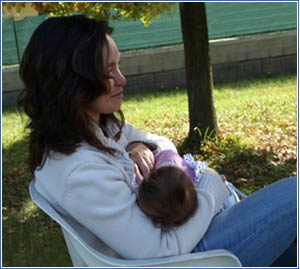Postpartum Interventions
At postpartum visits with the mother, focus on the following:
- Promote breast feeding
- Children who are breastfed are less likely to develop caries than those who are bottle fed, especially if there is ad lib use of bottles and sippy cups. Breast milk is a complex, highly specialized and dynamic source of nutrition for the infant, and contains antimicrobials and beneficial bacteria that help the infant establish a healthy oral microbiome that is more resistant to caries.
- Breastfeeding has multiple other proven health benefits.
- The American Academy of Pediatrics recommends that breastfeeding should be exclusive for the first 6 months of life and should continue to at least age 12 months or beyond, as desired by mother and child.
- Evidence suggests breastfeeding for longer than 12 months and frequent nocturnal breastfeeding can increase the risk of early childhood caries; however, breastfeeding offers many health benefits and should be continued for as long as desired by caregivers. Wiping the gums and teeth gently with moist gauze after each feeding can reduce the infant's caries risk.

- Promote high dose xylitol gum or chlorhexidine rinse programs for mom until child is age two.
- Xylitol can help decrease transmission of caries causing bacteria from mom to child.
- If chlorhexidine is used, use only for brief periods of time (i.e. weeks) to reduce the risk of tooth staining.
- Ensure children are not put to bed with a bottle.
- Teeth are at highest risk overnight when saliva levels are low.
- Gently clean infants' gums and teeth after breastfeeding, then brush twice daily with a smear of fluoride toothpaste once teeth erupt (AAP and AAPD recommendation).
- Recommend children see a dentist at 12 months of age.
- Encourage smoking cessation. Maternal smoking during pregnancy is associated with increased risk of early childhood caries, although more studies are needed to account for confounding variables. Possible mechanisms for increased caries risk include toxic effects of tobacco on developing dental structures in utero and during infancy and increased vertical transmission of S mutans due to the higher levels of the bacteria found in individuals who smoke.
References
Gomez SS, Weber AA Effectiveness of a Caries Prevention Program in Pregnant Women and Mothers on Their Offspring. Int J Pediatric Dent 2001;11:117-122.
Guideline on Infant Oral Health Care. AAPD. Revised 2014.
Lynch H, Milgrom P. Xylitol and dental caries: An overview for clinicians. Journal of the California Dental Association. March 2003.
Salone LR, Vann WF, Dee DL. Breastfeeding : An overview of the oral and general health benefits. JADA 2013; 144(2):143-151.
Arishi RA, Lai CT, Geddes DT and Stinson LF (2023) Impact of breastfeeding and other early-life factors on the development of the oral microbiome. Front. Microbiol. 14:1236601. doi: 10.3389/fmicb.2023.1236601
Shrestha, S.K.; Arora, A.; Manohar, N.; Ekanayake, K.; Foster, J. Association of Breastfeeding and Early Childhood Caries: A Systematic Review and Meta-Analysis. Nutrients 2024,16,1355. https://doi.org/ 10.3390/nu16091355
Samani, D., Ziaei, S., Musaie, F., & Mokhtari, H. (2024, July 12). Maternal smoking during pregnancy and early childhood dental caries in children: a systematic review and meta-analysis. National Institute of Health.